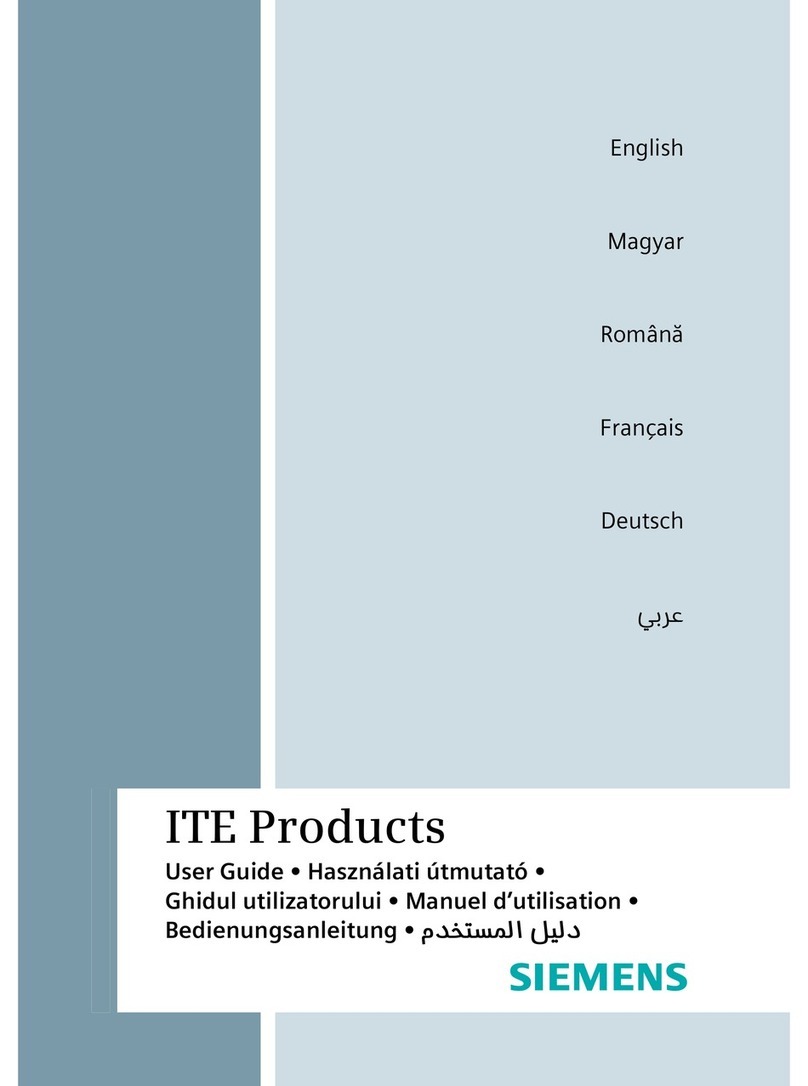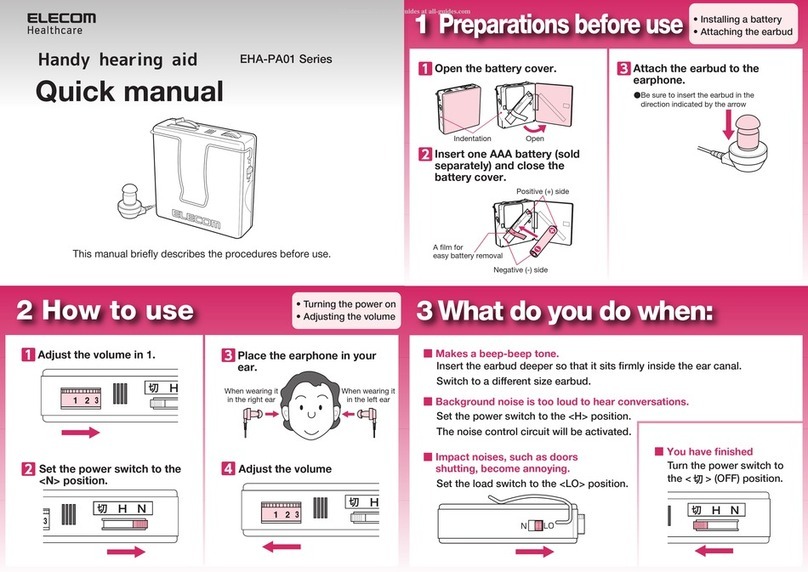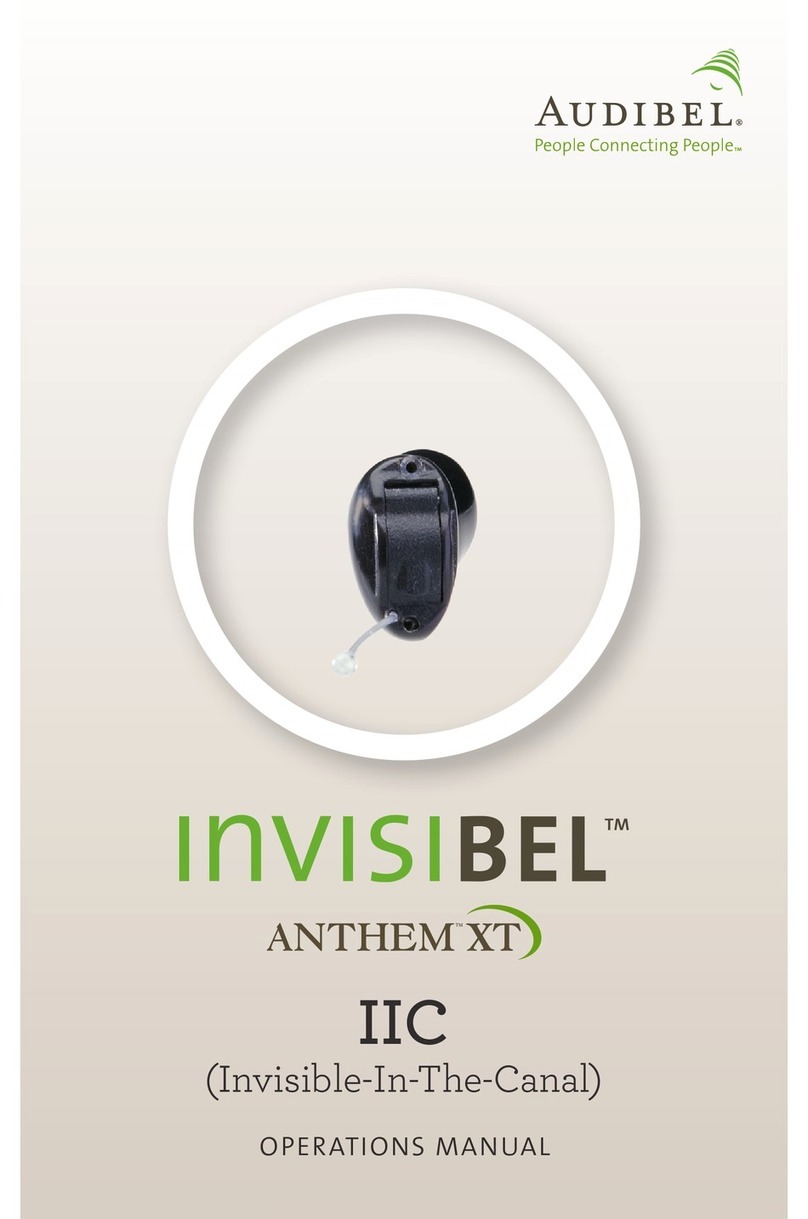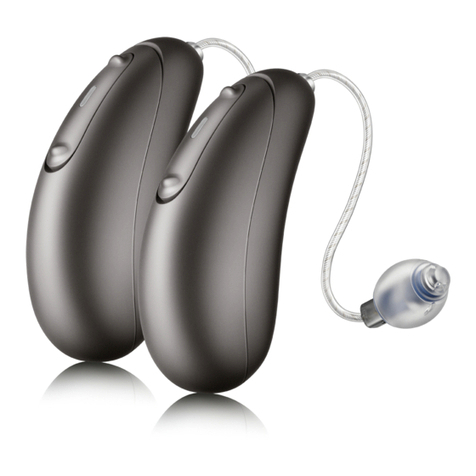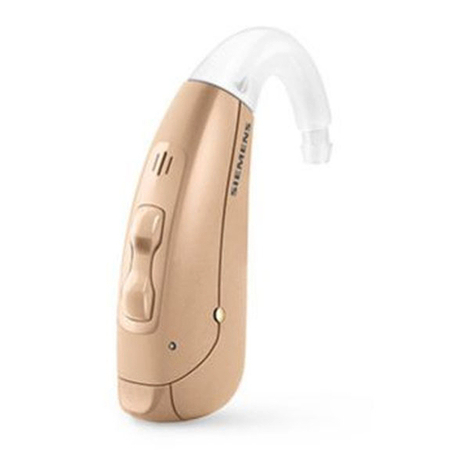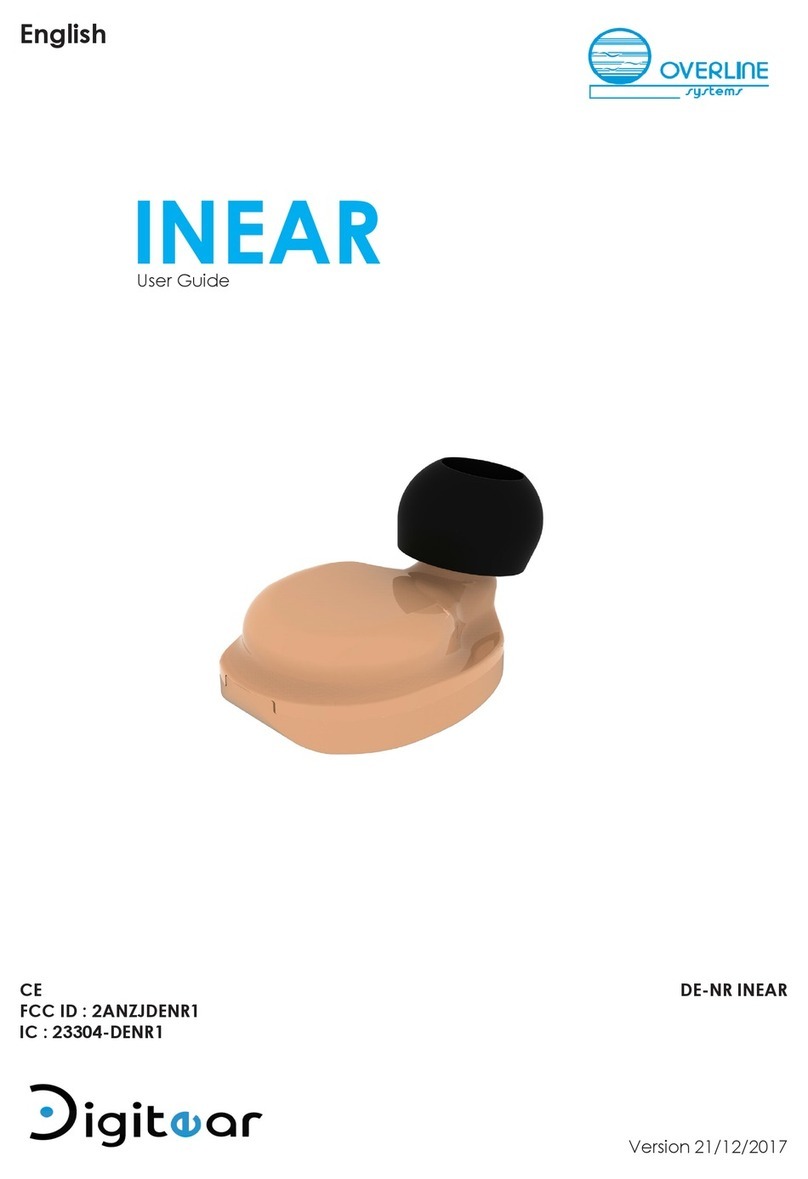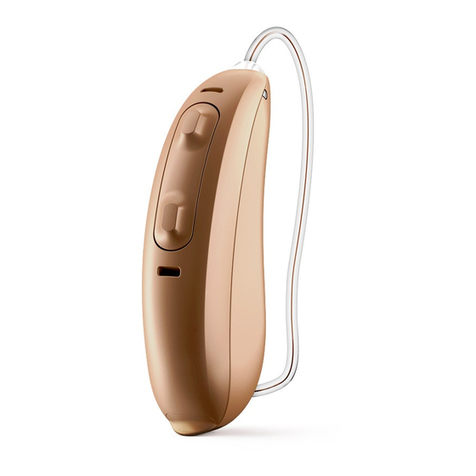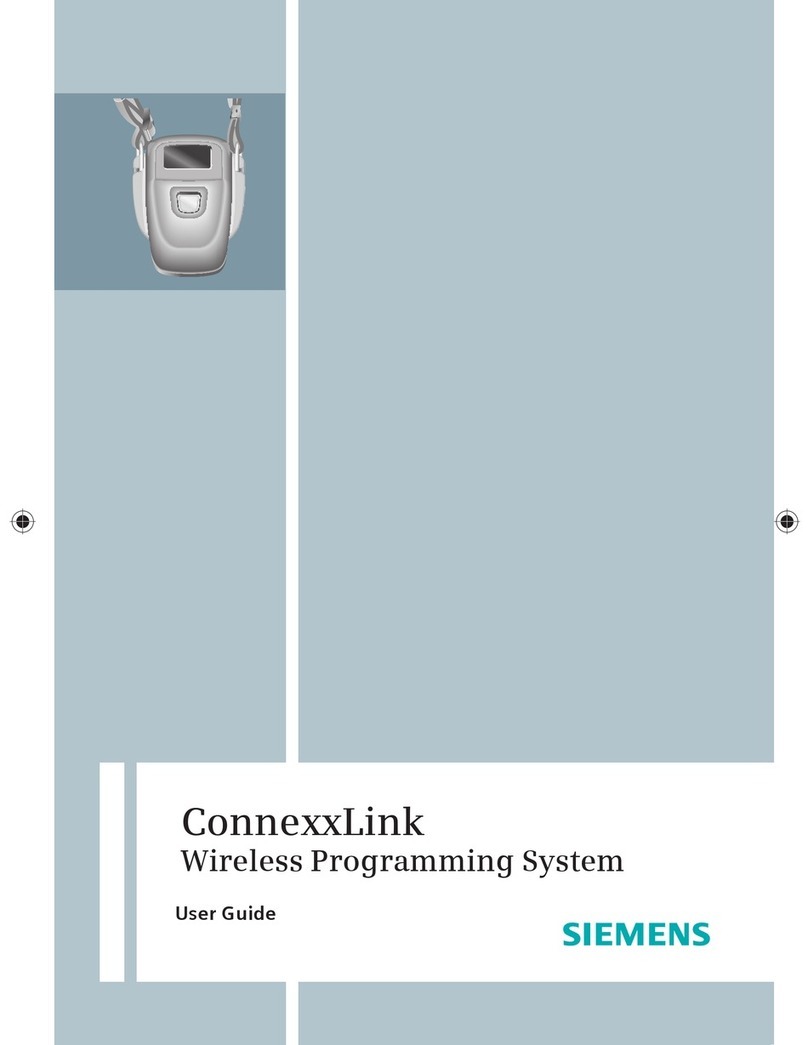Starkey Hearing Technologies RIC 10 User manual

Multiflex
Tinnitus
Technology
OPERATIONS MANUAL

3
Introduction............................................................................... 4
Overview
RIC 10 Overview................................................................ 5
Preparation
Batteries ............................................................................ 6
Battery Indicators .............................................................. 8
Tamper Resistant Battery Compartment ........................... 8
Insertion and Removal..................................................... 10
Operation
On & Off...........................................................................12
Multifunction Switch ........................................................12
Volume Control ...............................................................13
Multimemory ....................................................................14
Tinnitus Stimulus Control .................................................14
Telephone Use..................................................................16
Hearing System Care
Instrument Care................................................................19
Service and Repair........................................................... 21
Troubleshooting Guide ................................................... 22
Tips for Better Communication
For You ............................................................................ 23
For Your Family and Friends............................................ 24
Safety Information ...................................................................25
FDA Information ..................................................................... 26
Table of Contents

4 5
1211
42
13
5
7
10
6
8
9
Introduction
Multiflex Tinnitus Technology can be used as a part
of a tinnitus treatment program. Multiflex Tinnitus
Technology plays a white noise through the hearing aid.
The tinnitus stimulus is programmed according to your
hearing loss, and your hearing care professional can
adjust the settings of the tinnitus stimulus to meet
your needs.
Features, Controls and Identification
Your hearing system controls include:
1. Hearing Instrument
2. Cable
3. Receiver
4. Microphone
5. Multifunction Switch
6. Battery Compartment (on/off
control), Location of serial
number, Location of left/right
side device indicator
7. Retention Lock
8. Location of manufacturer’s
name and model name
9. Location of left/right side
receiver indicator
10. Instant Fit Earbud
11. Custom Earmold (optional)
12. RIC Custom Power Earmold
(optional)
RIC 10 Overview
Introduction

6 7
1 2
34
5
Batteries
Your hearing system uses a battery as its power source.
This battery size can be identified by the yellow (10)
code on the packaging.
To insert or replace the battery:
1. Use the nail grip on the battery door.
2. Open the battery door gently and remove
the old battery.
3. Remove the tab from the new battery.
4. Line up the battery’s plus “+” sign (flat side of
the battery) with the “+” on the battery door.
5. Close the battery door.
Preparation Preparation

8 9
My hearing instrument has a tamper resistant
battery compartment. See below.
Battery Indicators
An indicator will sound when the battery voltage is
low. You have approximately 5 minutes* to replace the
battery. An indicator will sound just before the battery
stops working.
Tamper Resistant Battery Compartment
To lock the battery door:
Use an appropriate tool to slide
the recessed switch to the left
until it “clicks” and
the colored mark is visible.
To unlock the battery door:
Slide the recessed switch to the
right until it “clicks” and the
colored mark disappears.
Locking the door is not required
for operation.
Helpful Hints
• NEVERFORCETHEBATTERYDOORSHUT;
thiscouldresultinseriousdamage;ifthedoor
will not close securely, check that the battery
is inserted correctly.
• Donotopenthebatterydoortoofaror
damage is likely to occur .
• Disposeofusedbatteriesimmediatelyintheproper
waste or recycling container.
• Becausebatteriescanvaryinsizeandperformance,
your hearing care professional is your best source for
lifespan estimates and verification that you are using
the proper size and type.
Warnings
Batteries are dangerous if swallowed. To help
prevent the accidental ingestion of batteries:
Keep out of reach of children and pets
Check your medications before taking them –
batteries have been mistaken for pills
Neverputbatteriesinyourmouth,astheycan
easily be swallowed
National Switch Battery Ingestion Hotline:
202-625-3333
* Actual time between low battery indicator and shut down will vary depending on
environmental noise levels and brand of battery used.
Preparation Preparation

10 11
Insertion and Removal
To insert the earbud or eartip:
1. Hold the cable at the bend in
front of the receiver with your
thumb and forefinger. Gently
insert the receiver into your
ear canal.
2. Carefully place the hearing
instrument behind your ear,
wrapping it over the top of
your ear.
3. Place the retention lock inside the
bowl of your ear.
To remove the earbud or eartip:
1. Remove the retention lock from
the bowl of your ear.
2. Remove the hearing instrument
from behind your ear.
3. Grasp the receiver with your
thumb and forefinger. Gently pull
out of your ear canal.
Donotpullwiththehearing
instrument case as this may damage
the connection.
Helpful Hints
•
Minor irritation and inflammation may occur as your
earbecomesaccustomedtohavinganobjectinit;
if so, please contact your hearing care professional.
•
If an actual allergic reaction occurs, alternative
earmoldmaterialsareavailable;contactyour
hearing care professional.
•
Severe swelling, discharge from the ear, excessive
wax, or other unusual conditions warrant immediate
consultation with a physician.
Preparation Preparation

12 13
My hearing instrument volume is set automatically.
Please read the section at the top of page 13.
My hearing instrument uses the switch for
volume control. See page 13.
My hearing instrument uses the switch for
multimemory. See page 14.
My hearing instrument uses the switch for
tinnitus stimulus control. See page 14.
My hearing instrument has combined volume
and tinnitus stimulus control. See page 15.
My hearing instrument has combined multimemory
and tinnitus stimulus control. See page 15.
Volume Level Tone
Level 5 (More volume) Five beeps plus tone
Level 4 Four beeps
Level 3 (Power on volume level) Three beeps
Level 2 Two beeps
Level 1 (Less volume) One beep plus tone
On & Off
To turn ON:
Insert a battery and completely close
the battery door.
To turn OFF:Open the battery door until the battery is
no longer touching the battery contacts.
Your instrument has a Power-On delay and may require
a few seconds to power on. You may hear a tone series
indicating that your device is fully powered on.
Multifunction Switch
Your switch can be set to perform different functions.
Ask your hearing care professional how your device
is set.
Automatic Volume Control
Your hearing system has been set to a specific volume
level by your hearing care professional. If sounds are
generally too loud or too soft, please contact your
hearing care professional for advice and adjustment.
Volume Control
Your hearing system uses the switch to control hearing
aid volume. Press then release the switch until the
desired volume level is reached. Each press/release
changes the volume one increment.
Volume Settings
Operation Operation

14 15
Operation Operation
Multimemory
Your hearing care professional can set up to four
hearing programs for you. These additional programs
are accessed by pressing the multifunction switch.
When you press the multifunction switch, you may hear
an indicator or tone series indicating the device has
changed to the next program.
Ask your hearing care professional about your specific
hearing programs.
Tinnitus Stimulus Control
Your hearing system uses the multifunction switch to
control the tinnitus stimulus. Press then release the
switch until the desired level is reached. Each press/
release changes the volume one increment.
Combined Volume and
Tinnitus Stimulus Control
Your hearing system is set up to adjust volume and
tinnitus stimulus. To adjust volume, press then release
the switch until the desired volume level is reached.
To adjust the tinnitus stimulus, press and hold the
switch. The hearing aid will cycle through the tinnitus
stimulus levels. Release the switch when you are at the
desired level.
Combined Multimemory and
Tinnitus Stimulus Control
Your hearing system is set up to adjust multimemory
and tinnitus stimulus. To adjust memory, press then
release the switch until the desired memory is reached.
To adjust the tinnitus stimulus, press and
hold the switch. The hearing aid will cycle through
the tinnitus stimulus levels. Release the switch when
you are at the desired level.

16 17
Telecoil and Manual Switching
Hearing instruments with a
manual telecoil allow you to
switch the devices to telephone
mode when needed.
Manually switched telecoils
are activated by choosing the
telecoil setting using the
Multifunction switch.
General Telephone Use
Some hearing instruments
work best by holding the phone
close to, but not fully covering
your ear. In some instances,
if you encounter whistling
(feedback), tilt the receiver at
an angle until the whistling
stops. Your hearing professional
can provide instructions and
techniques for your specific
needs.
Telephone Use
Your hearing instruments are equipped with tools to help
you effectively communicate on the telephone. Ask your
hearing professional about your telephone solution.
Automatic Telephone and Automatic Telecoil
These options activate the telephone response
automatically when used with a hearing aid compatible
telephone. To use, place the telephone receiver
on your ear as you normally would and the hearing
instrument will select the telephone setting. It might be
necessary to move the telephone receiver slightly to
find the best reception. Once the telephone is removed
from the ear, the hearing instrument will switch back to
the normal listening mode.
NOTE: Consult with your hearing professional if your
device does not seem to switch to the telephone
setting automatically.
OperationOperation
My hearing instruments have the following telephone
setting(s):
Automatic Telephone. See below.
Automatic Telecoil. See below.
Telecoil and Manual Switching. See page 17.
(Program # ____________________ ).

18 19
80
Starkey offers various methods of wax protection for your hearing instruments.
The following is a brief description of some of our wax protection options:
WAX PROTECTION GUIDE
HearClear™*
The Hear Clear exclusive earwax
protection system uses disposable
wax guards. The innovative wax
guards prevent earwax accumulation
in the hearing aid receiver. The Hear
Clear is incompatible with Extended
Receiver Tube, Biconic Wax Guard
and Canal Bell.
Biconic Wax Guard (Wax Spring)
The Biconic Wax Guard is a small coil basket inserted into the
receiver tubing of the hearing aid to prevent wax from reaching
the receiver. The wax spring is typically removed and replaced by a
hearing professional.
Extended Receiver Tubing
The Extended Receiver Tubing increases the distance wax must travel
before reaching the receiver. It potentially allows the user to visualize
the presence of wax before it enters the receiver of the hearing aid.
The Extended Receiver Tubing is incompatible with Waxceptor.
Canal Bell
The Canal Bell recesses the receiver of the hearing aid, making
it more difficult for wax to reach the receiver. The Canal Bell is
incompatible with the Waxceptor.
DISCLAIMER – Some hearing aid users have reported
a buzzing sound in their hearing aids when they are
using cell phones, indicating that the cell phone and
hearing aid may not be compatible. According to the
ANSIC63.19standard(ANSIC63.19-2006American
NationalStandardMethodsofMeasurementof
Compatibility Between Wireless Communications
DevicesandHearingAids),thecompatibilityofa
particular hearing aid and cell phone can be predicted
by adding the rating for the hearing aid immunity to
the rating for the cell phone emissions. For example,
the sum of a hearing aid rating of 2 (M2) and a
telephone rating of 3 (M3) would result in a combined
rating of 5. Any combined rating that equals at least 5
wouldprovide“normaluse”;acombinedratingof6or
greater would indicate “excellent performance.”
The immunity of this hearing aid is at least M2/T2.
The equipment performance measurements, categories
and system classifications are based upon the best
information available but cannot guarantee that all
users will be satisfied.
NOTE: The performance of individual hearing aids
may vary with individual cell phones. Therefore, please
try this hearing aid with your cell phone or, if you are
purchasing a new phone, be sure to try it with your
hearing aid prior to purchase. For additional guidance,
please ask your cell phone provider for the booklet
entitled“HearingAidCompatibilitywithDigital
Wireless Cell Phones.”
Instrument Care
Doyourbesttokeepyourhearinginstrumentcleanat
all times. Heat, moisture and foreign substances can
result in poor performance.
• Useacleaningbrushorsoftclothtoclean
debris from around the switches, microphone,
andbatterycompartment;inspectthereceiver,
earbud or eartip and Wax Guard regularly.
• Neverusewater,solvents,cleaninguidsoroilto
clean your instrument.
Your hearing care professional can provide further
information on additional maintenance procedures for
your hearing system if needed.
Hear Clear™
The Hear Clear exclusive
earwax protection system
uses disposable wax
guards. The innovative wax
guards prevent earwax
accumulation in the hearing
aid receiver.
Operation Hearing System Care

20 21
Service and Repair
If, for any reason, your hearing system does not operate
properly,doNOTattempttoxityourself.Notonly
are you likely to violate any applicable warranties or
insurance, you could easily cause further damage.
Should your hearing system fail or perform poorly,
check the guide on the next page for possible
solutions. If problems continue, contact your hearing
care professional for advice and assistance. Many
common problems may be solved right in your hearing
care professional’s office or clinic.
Helpful Hints
• Whennotwearingyourhearingsystem,
open the battery door to allow any moisture
to evaporate.
• Whennotinuse,removethebatteriescompletely;
place your hearing system in the storage container
and store:
– In a dry, safe place
– Away from direct sunlight or heat to
avoid extreme temperatures
– Where you can easily find them
– Safely out of reach of pets and children
• Donottakeapartyourhearinginstrumentsorinsert
the cleaning tools inside them.
Hearing System CareHearing System Care

22 23
Hearing System Care Tips for Better Communication
SYMPTOM POSSIBLE
CAUSES
SOLUTIONS
NotLoud
Enough
Low battery Replace battery
Blocked
earmold/tubing/
earbud
Clean or replace Wax
Guard as needed
Hearing change Contact your hearing
care professional
Debrisbuildup Clean both microphone
and receiver with brush
Inconsistent
Performance
Low battery Replace battery
Blocked
earmold/tubing/
earbud
Clean or replace Wax
Guard as needed
Unclear,
Distorted
Performance
Low battery Replace battery
Blocked
earmold/tubing/
earbud
Clean or replace Wax
Guard as needed
Defectivehearing
instrument
Contact your hearing
care professional
Dead
Low battery Replace battery
Blocked
earmold/tubing
Clean or replace Wax
Guard as needed
Crimped tubing Contact your hearing
care professional
Your hearing care professional will recommend an
appropriate schedule to help you adapt to your new
hearing system. It will take practice, time and patience
for your brain to adapt to the new sounds that your
hearing system provides. Hearing is only part of how
we share thoughts, ideas and feelings. Reading lips,
facial expressions and gestures can help the learning
process and add to what amplification alone may miss.
Please review the following simple communication tips:
For You
• Moveclosertoandlookatthespeaker
• Sitface-to-faceinaquietroom
• Trydifferentlocationstondthebestplacetolisten
• Minimizedistractions
• Backgroundnoisesmaybefrustratingatrst;
remember, you have not heard them for a while
• Letothersknowwhatyouneed;keepinmindthat
people cannot “see” your hearing loss
• Developrealisticexpectationsofwhatyourhearing
instruments can and cannot do
• Betterhearingwithhearinginstrumentsisalearned
skill combining desire, practice and patience
Troubleshooting Guide

24 25
For Your Family and Friends
Your family and friends are also affected by your
hearing loss. Request that they:
• Getyourfullattentionbeforebeginning
to speak
• Lookatyouorsitface-to-faceinaquietroom
• Speakclearlyandatanormalrateandlevel;shouting
can actually make understanding more difficult
• Rephraseratherthanrepeatthesamewords;
different words may be easier to understand
• Minimizedistractionswhilespeaking
Tips for Better Communication Safety Information
Safety Information
Your hearing instruments should not be worn during
an MRI procedure or in a hyperbaric chamber.
Your hearing instruments are classified as a Type B
applied part under the IEC 60601-1 medical
device standard.
Your hearing instruments are not formally certified
to operate in explosive atmospheres such as may
be found in coal mines or certain chemical factories.
Your hearing instruments should be stored within the
temperature and humidity ranges of -40oC (-40oF) to
+60oC (140oF) and 10%-95% rH.
Your hearing instruments are designed to operate
beyond the range of temperatures comfortable to
you, from very cold up to 50oC (122oF).

26 27
Required Information
The following additional information is provided in compliance with U.S.
FoodandDrugAdministration(FDA)regulations:
WARNING TO HEARING AID DISPENSERS. A hearing aid dispenser
should advise a prospective hearing aid user to consult promptly with
a licensed physician (preferably an ear specialist) before dispensing a
hearing aid if the hearing aid dispenser determines through inquiry, actual
observation, or review of any other available information concerning
the prospective user, that the prospective user has any of the following
conditions:
i. Visible congenital or traumatic deformity of the ear.
ii. History of active drainage from the ear within the previous 90 days.
iii. History of sudden or rapidly progressive hearing loss within the
previous 90 days.
iv. Acute or chronic dizziness.
v. Unilateral hearing loss of sudden or recent onset within the previous
90 days.
vi. Audiometric air-bone gap equal to or greater than 15 decibels at
500 Hertz (Hz), 1,000 Hz and 2,000 Hz.
vii. Visible evidence of significant cerumen accumulation or a foreign
body in the ear canal.
viii. Pain or discomfort in the ear.
IMPORTANT NOTICE FOR PROSPECTIVE HEARING AID USERS.
Good health practice requires that a person with a hearing loss have a
medical evaluation by a licensed physician (preferably a physician who
specializes in diseases of the ear) before purchasing a hearing aid.
Licensed physicians who specialize in diseases of the ear are often referred
to as otolaryngologists, otologists, or otorhynolaryngologists. The purpose
of the medical evaluation is to assure that all medically treatable conditions
that may affect hearing are identified and treated before the hearing aid is
purchased.
Following the medical evaluation, the physician will give you a written
statement that states that your hearing loss has been medically evaluated
and that you may be considered a candidate for a hearing aid. The
physician will refer you to an audiologist or hearing aid dispenser, as
appropriate, for a hearing aid evaluation.
FDA Information
The audiologist or hearing aid dispenser will conduct a hearing aid
evaluation to assess your ability to hear with and without a hearing aid.
The hearing aid evaluation will enable the audiologist or dispenser to
select and fit a hearing aid to your individual needs.
If you have reservations about your ability to adapt to amplification, you
should inquire about the availability of a trial-rental or purchase-option
program. Many hearing aid dispensers now offer programs that permit
you to wear a hearing aid for a period of time for a nominal fee after
which you may decide if you want to purchase the hearing aid.
Federal law restricts the sale of hearing aids to those individuals who
have obtained a medical evaluation from a licensed physician. Federal
law permits a fully informed adult to sign a waiver statement declining
the medical evaluation for religious or personal beliefs that preclude
consultation with a physician. The exercise of such a waiver is not in
your best health interest and its use is strongly discouraged.
A hearing aid will not restore normal hearing and will not prevent or
improve a hearing impairment resulting from organic conditions. Use
of a hearing aid is only part of hearing habilitation and may need to be
supplemented by auditory training and instruction in lip reading. In most
cases infrequent use of a hearing aid does not permit a user to attain full
benefit from it.
CHILDREN WITH HEARING LOSS. In addition to seeing a physician for
a medical evaluation, a child with a hearing loss should be directed to an
audiologist for evaluation and rehabilitation since hearing loss may cause
problems in language development and the educational and social growth
of a child. An audiologist is qualified by training and experience to assist in
the evaluation and rehabilitation of a child with a hearing loss.
For hearing care professionals
INDICATIONS FOR USE
The Multiflex Tinnitus Technology is a tool to generate sounds to be
used in a Tinnitus Management Program to relieve patients suffering
from tinnitus. The target population is primarily the adult population
over 18 years of age.
The Multiflex Tinnitus Technology is targeted for healthcare professionals,
which are treating patients suffering from tinnitus, as well as conventional
hearing disorders. The fitting of the Multiflex Tinnitus Technology
must be done by a hearing professional participating in a Tinnitus
Management Program.
FDA Information

28 29
DEVICE DESCRIPTION
Multiflex Tinnitus Technology is a software function that generates sound
which is programmed into a hearing aid. The hearing aid may be used in
one of three modes of operation: as a hearing aid, as a tinnitus treatment
device, or as a hearing aid and tinnitus treatment device.
When enabled, the Multiflex Tinnitus Technology generates the sound
and allows a patient’s hearing care professional to design and program
appropriate settings for an individually prescribed sound treatment plan.
The treatment plan should be used in a tinnitus management program for
relief of tinnitus.
Multiflex Tinnitus Technology generates a broadband white noise signal
that varies in frequency and amplitude. These characteristics are adjustable
by the hearing care professional and are specific to the prescribed therapy
designed by the professional for the patient’s needs and comfort.
The patient may have some control of the level or volume of the signal and
the patient should discuss this adjustment as well as his or her comfort level
and sound of the signal with their hearing care professional.
WARNING TO HEARING CARE PRACTITIONER
A hearing care practitioner should advise a prospective sound generator
user to consult promptly with a licensed physician (preferably an ear
specialist) before using a sound generator if the hearing care practitioner
determines through inquiry, actual observation, or review or any other
available information concerning the prospective user that the prospective
user has any of the following conditions:
i. Visible congenital or traumatic deformity of the ear.
ii History of active drainage from the ear within the previous 90 days.
iii History of sudden or rapidly progressive hearing loss within the
previous 90 days.
iv Acute or chronic dizziness.
v Unilateral hearing loss of sudden or recent onset within the
previous 90 days.
CAUTION: If set to the maximum output level and worn for periods of time
exceeding the recommendations below, the patient’s exposure to sound
energy has the potential to exceed noise exposure limits. This device is
intended for use for a maximum of sixteen (16) hours a day when set at the
maximum output level.
FDA Information
For the patient
A tinnitus therapy device is an electronic device intended to generate
noise of sufficient intensity and bandwidth to treat ringing in the ears.
It can also be used as an aid in hearing external sounds and speech.
Multiflex Tinnitus Technology is a tool to generate sounds. It is
recommended that this tool be used with appropriate counseling and/or in
a tinnitus management program to relieve patients suffering from tinnitus.
TINNITUS THERAPY CONCEPTS AND BENEFITS
Multiflex Tinnitus Technology can be used as a part of a tinnitus
treatment program.
Multiflex Tinnitus Technology plays a white noise through the hearing aid.
Multiflex Tinnitus Technology is programmed according to your hearing loss
and preference, and your hearing care professional can adjust the settings
of Multiflex Tinnitus Technology to meet your needs.
Multiflex Tinnitus Technology may provide temporary relief of your tinnitus.
PRESCRIPTION USE ONLY
CAUTION: Federal law restricts this device to sale by or on the order of a
doctor, audiologist or other hearing care practitioner licensed to dispense
hearing instruments in your state.
The use of any sound generating tinnitus therapy device should be only
on the advice and in consultation with your audiologist or hearing care
practitioner. Your hearing care professional will properly diagnose and fit
the device to your personal needs and requirements. This should include its
use in a prescribed tinnitus treatment program.
Your hearing care professional will also be able to offer the appropriate
follow-up care. It is important that you follow your hearing care
professional’s advice and direction regarding such care.
WARNING
There are some potential concerns associated with the use of any sound
generating tinnitus therapy device. Among them are the potential for
worsening of tinnitus, a possible change in hearing thresholds, and possible
skin irritation at the point of contact with the device.
Multiflex Tinnitus Technology has been designed to minimize these
concerns. However, should you experience or notice any of the above
conditions or any dizziness, nausea, headaches, or heart palpitations, you
should immediately discontinue use of the device and seek a consultation
with a medical, audiology, or other hearing care professional.
FDA Information

30 31
FDA Information
As with any device, misuse of the tinnitus therapy device could present
some potentially harmful effects. Care should be taken to prevent the
unauthorized use and to keep the device out of the reach of children
and pets.
CAUTION: If set to the maximum output level and worn for periods of
time exceeding the recommendations below, your exposure to sound
energy has the potential to exceed noise exposure limits. You should not
use your hearing device for more than sixteen (16) hours a day if your
device is set at the maximum output level, nor should you use your device
if your hearing care professional has set the device at levels that exceed
your comfort level.
Important notice for prospective
sound generator users
Good health practice requires that a person with tinnitus have a medical
evaluation by a licensed physician (preferably a physician who specializes
in diseases of the ear) before using a sound generator. Licensed
physicians who specialize in diseases of the ear are often referred to as
otolaryngologists, otologists, or otorhinolaryngologists.
The purpose of a medical evaluation is to assure that all medically treatable
conditions that may affect tinnitus are identified and treated before the
sound generator instrument is used.
TECHNICAL DATA
Multiflex Tinnitus Technology Maximum Output = 87 dB SPL (typical) when
measuredina2cccouplerperANSIS3.22orIEC60118-7.
Starkey Hearing Technologies
6700 Washington Avenue South
EdenPrairie,MN55344
Wm. F. Austin House, Bramhall Technology Park
Pepper Road, Hazel Grove, Stockport SK7 5BX
United Kingdom
Waste from electronic equipment must be
handled according to local regulations
0086
Notes

0086
© 2012 Starkey Hearing Technologies. All Rights Reserved.
81016-007 12/12 BKLT2606-00-EE-XX Rev. A
Other manuals for RIC 10
1
Table of contents
Other Starkey Hearing Technologies Hearing Aid manuals

Starkey Hearing Technologies
Starkey Hearing Technologies dash B1000-001 Specification sheet
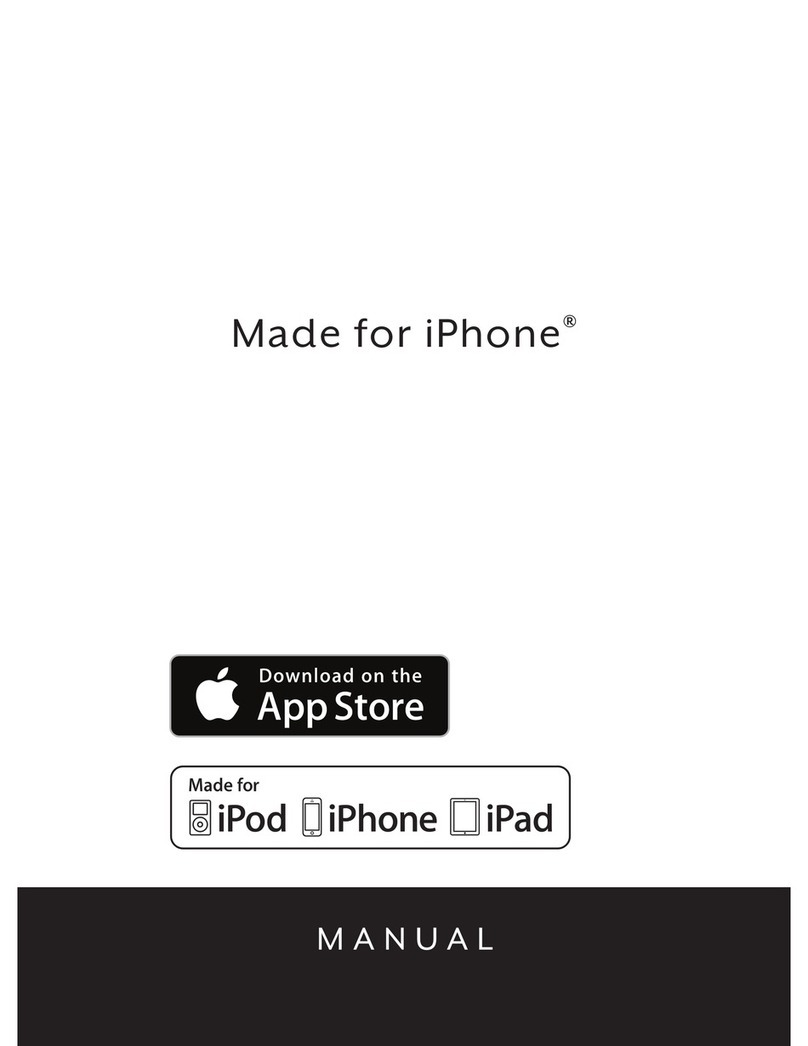
Starkey Hearing Technologies
Starkey Hearing Technologies BTE 13 User manual
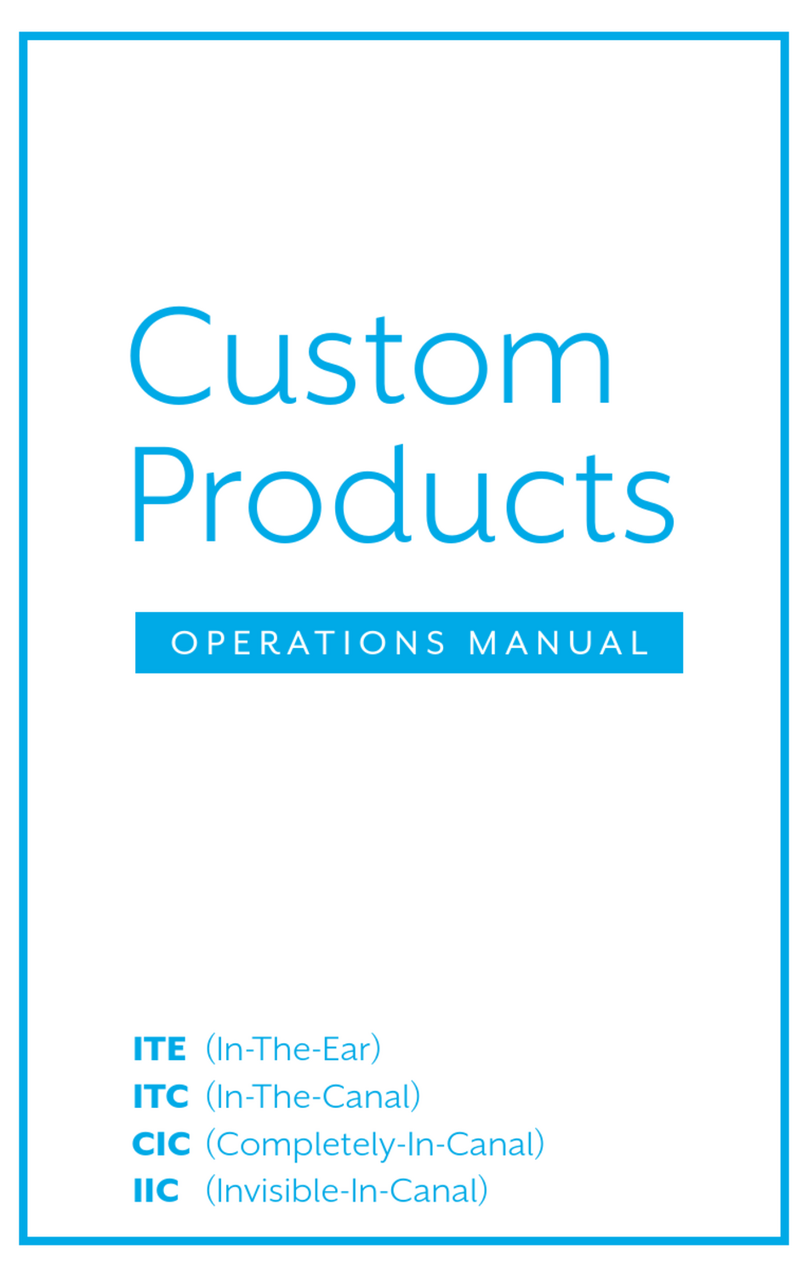
Starkey Hearing Technologies
Starkey Hearing Technologies ITE User manual

Starkey Hearing Technologies
Starkey Hearing Technologies RIC User manual

Starkey Hearing Technologies
Starkey Hearing Technologies Remote Assembly instructions
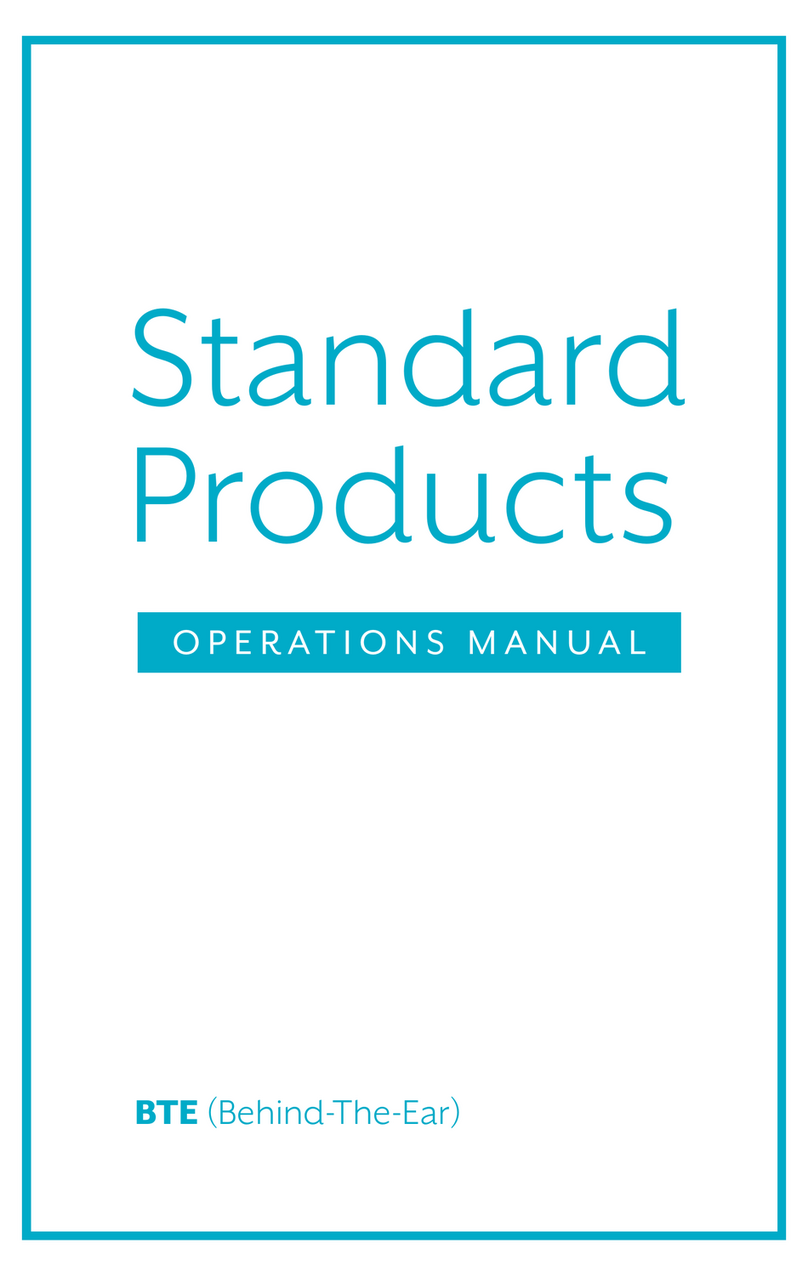
Starkey Hearing Technologies
Starkey Hearing Technologies Rocker Switch BTE 313 User manual
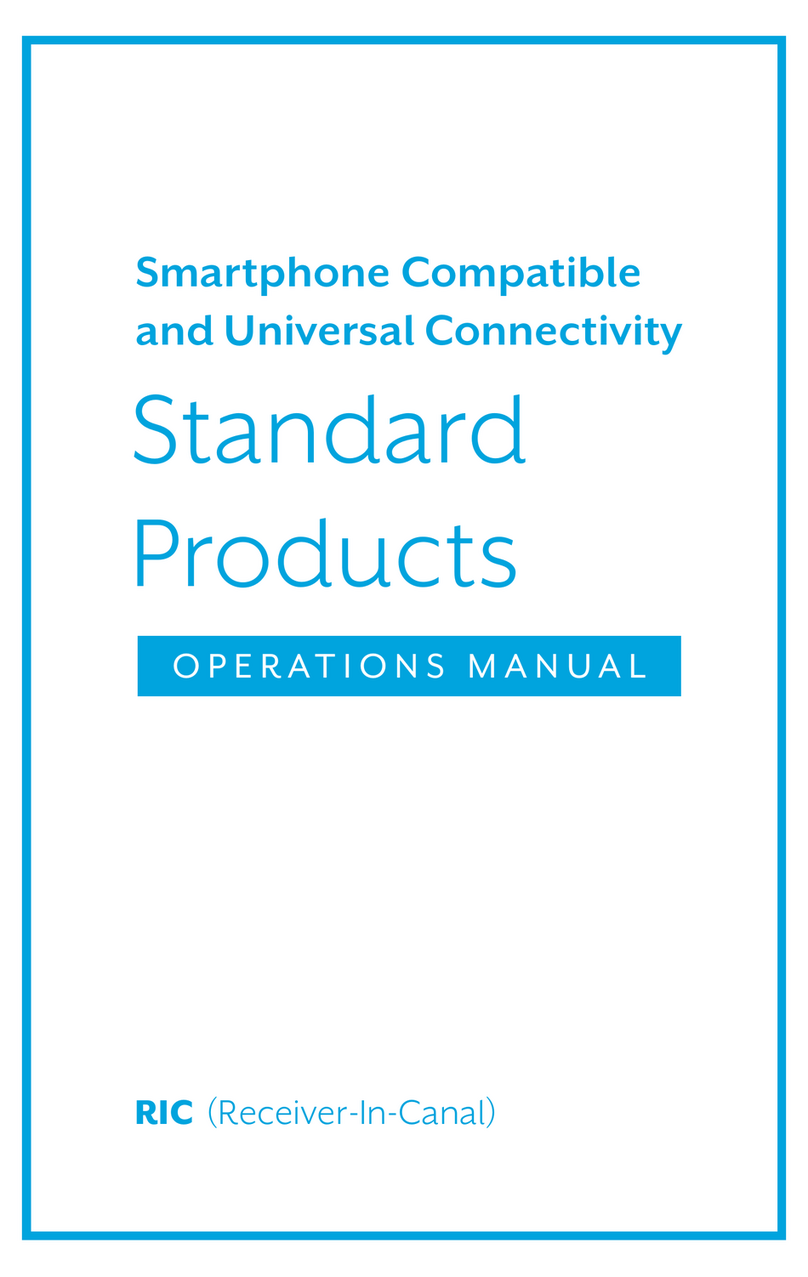
Starkey Hearing Technologies
Starkey Hearing Technologies Rocker switch RIC 312 User manual
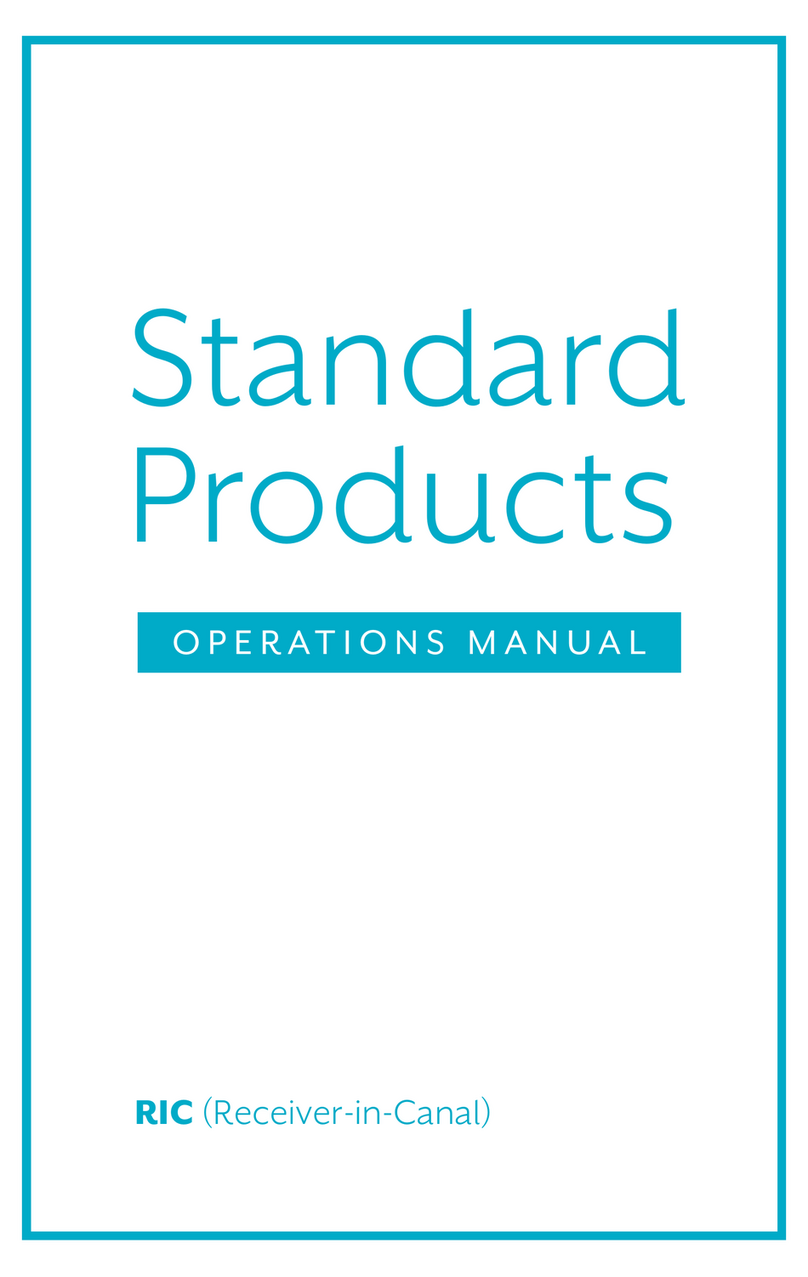
Starkey Hearing Technologies
Starkey Hearing Technologies RIC 10 User manual

